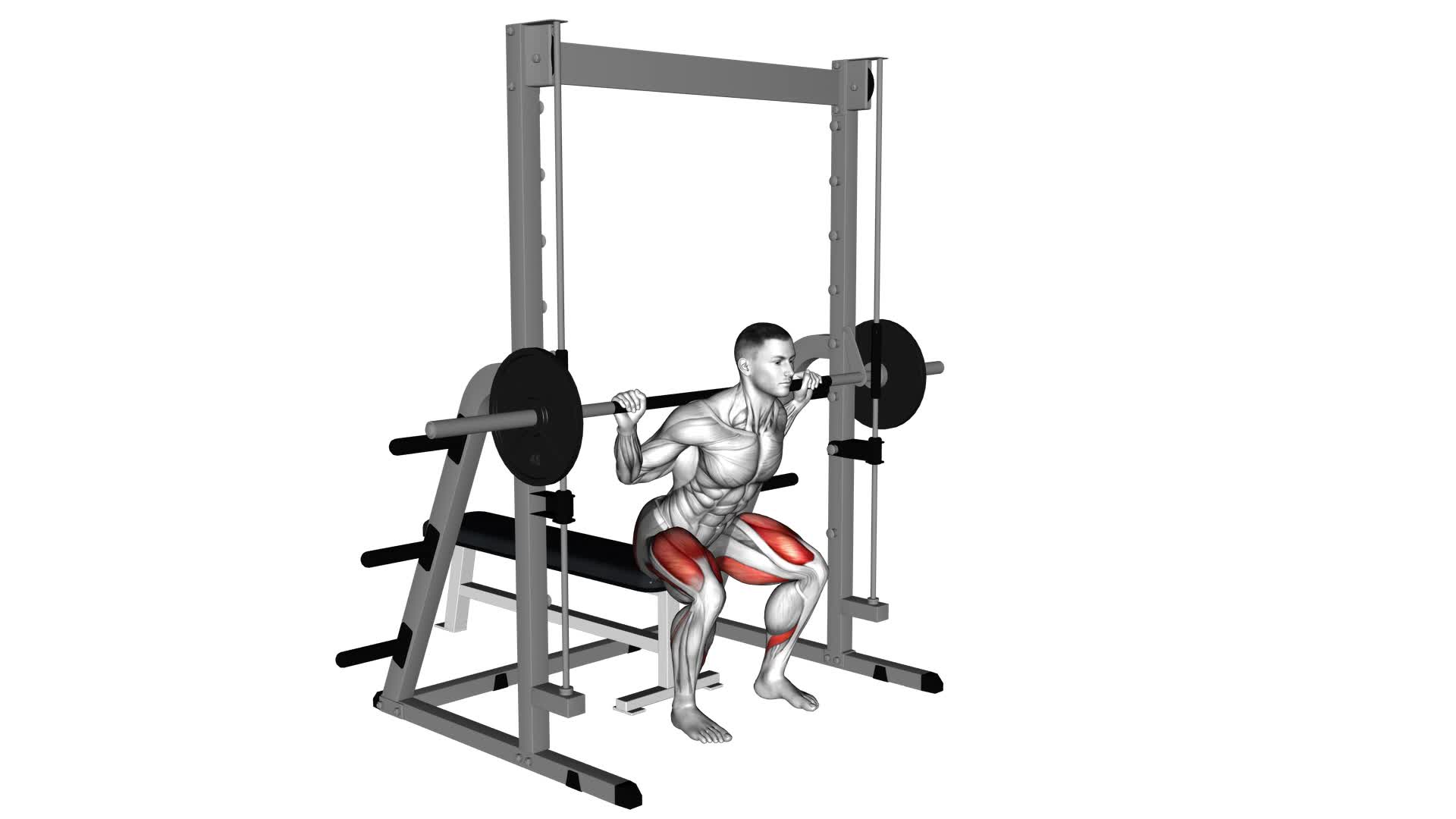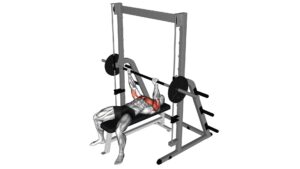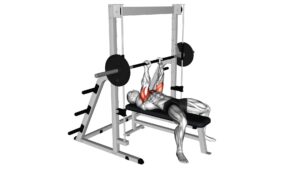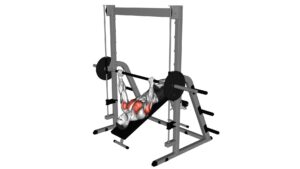Smith Squat to Bench – Video Exercise Guide & Tips

Looking to amp up your leg workout? Check out this video exercise guide for the Smith Squat to Bench!
Watch This Exercise Video
With its focus on lower body strength and stability, this exercise is sure to challenge you.
Learn the proper form and technique, as well as variations and progressions to keep your routine fresh.
Avoid common mistakes and get tips for a safe and effective workout.
Get ready to take your leg day to the next level!
Key Takeaways
- Smith Squat to Bench reduces the risk of knee and lower back injuries.
- This exercise targets quadriceps, hamstrings, glutes, and calves.
- It improves lower body strength and stability.
- Smith Squat to Bench can enhance athletic performance and increase power and muscle definition.
Benefits of Smith Squat to Bench
You can experience a range of benefits by incorporating the Smith Squat to Bench exercise into your workout routine. This exercise not only helps in building strength and muscle mass but also offers various other advantages.
One of the key benefits of the Smith Squat to Bench is injury prevention. By performing this exercise correctly and with proper form, you can significantly reduce the risk of injury to your knees and lower back. The controlled movement and support provided by the Smith machine allow you to focus on your form and maintain stability throughout the exercise, minimizing the chances of strain or overextension.
Additionally, the Smith Squat to Bench targets multiple muscle groups, including your quadriceps, hamstrings, glutes, and calves, helping to improve overall lower body strength and stability. By incorporating this exercise into your routine, you can enhance your athletic performance, increase your power and explosiveness, and achieve better muscle definition.
Now, let's move on to the next section and explore the proper form and technique for performing the Smith Squat to Bench exercise.
Proper Form and Technique
To perform the Smith Squat to Bench exercise with proper form and technique, it's important to maintain control and stability throughout the movement. This will help you maximize the benefits of the exercise and reduce the risk of injury.
One common mistake is allowing your knees to cave inwards as you squat down. This can put excessive strain on your knees and increase the risk of injury. To prevent this, focus on pushing your knees outwards and maintaining proper alignment throughout the movement.
Another common mistake is using too much weight, which can compromise your form and lead to injury. Start with a weight that allows you to maintain proper form and gradually increase the weight as you become stronger and more confident with the exercise.
Lastly, make sure to keep your core engaged and your back straight throughout the movement. This will help you maintain stability and prevent any unnecessary strain on your lower back.
By following these tips, you can perform the Smith Squat to Bench exercise safely and effectively.
Now, let's move on to discuss variations and progressions of this exercise.
Variations and Progressions
As you progress with the Smith Squat to Bench exercise, you can incorporate variations and progressions to challenge your muscles and continue making gains.
There are several Smith Squat variations that you can try to target different muscle groups and add variety to your workout routine. One variation is the Smith Squat with a narrow stance, which places more emphasis on your quadriceps.
Another variation is the Smith Squat with a wide stance, which targets your glutes and inner thighs. You can also try the Smith Squat with a pause at the bottom position to increase time under tension and further stimulate your muscles.
In addition to variations, you can also incorporate progressions and modifications to make the Smith Squat to Bench exercise more challenging. One progression is to increase the weight on the Smith machine, gradually adding more resistance as you get stronger.
You can also try performing the exercise on an unstable surface like a BOSU ball or a balance board to engage your core muscles and improve stability.
The benefits of incorporating Smith Squat variations and progressions into your workout routine are numerous. By targeting different muscle groups and adding variety, you can prevent plateaus and keep your muscles guessing, leading to continued gains in strength and muscle size.
Additionally, by challenging your muscles with new variations and progressions, you can improve your overall functional strength and stability.
Common Mistakes to Avoid
When performing the Smith squat to bench exercise, it's crucial to maintain proper form to avoid injury and maximize results.
Avoid the common mistake of using excessive weight, as it can lead to compromised form and potential strain on your muscles and joints.
Proper Form Importance
Ensure that you maintain proper form throughout the Smith Squat to Bench exercise to avoid common mistakes and maximize your results.
Proper form is crucial because it allows you to target the right muscles and minimize the risk of injury. One important aspect of proper form is alignment. Make sure your feet are shoulder-width apart, knees in line with your toes, and your back straight throughout the movement. This will help distribute the load evenly and protect your joints.
Additionally, engaging your core is vital for stability and control. Keep your abs tight and your back flat to maintain a strong and stable posture.
Avoiding Excessive Weight
Maintain proper form and avoid excessive weight when performing the Smith Squat to Bench exercise to prevent common mistakes and maximize your results.
To avoid injury and maintain proper balance, consider the following:
- Start with a weight that challenges you, but that you can comfortably control throughout the movement.
- Avoid adding too much weight too quickly, as this can compromise your form and increase the risk of injury.
- Focus on maintaining a stable and balanced position throughout the exercise by keeping your core engaged and your back straight.
By avoiding excessive weight and prioritizing proper form, you can reduce the risk of injury and ensure that you're getting the most out of your Smith Squat to Bench workout.
Tips for a Safe and Effective Workout
To have a safe and effective workout, it's important to focus on proper form techniques. This means maintaining good posture, engaging the correct muscles, and using the appropriate range of motion.
Additionally, injury prevention strategies such as warming up, stretching, and using proper equipment should be incorporated.
Lastly, efficient workout routines that target specific muscle groups and allow for adequate rest and recovery should be followed for optimal results.
Proper Form Techniques
Maximize your workout efficiency and minimize the risk of injury by implementing proper form techniques during the Smith Squat to Bench exercise. To ensure a safe and effective workout, it's crucial to pay attention to your form.
Here are some common mistakes in form to avoid and the importance of proper technique:
- Common mistakes in form:
- Rounded back: Keep your spine neutral and engage your core to prevent straining your lower back.
- Knee cave: Maintain proper alignment by pushing your knees outwards throughout the movement.
- Shallow squats: Descend until your thighs are parallel to the ground to fully engage your muscles.
- Importance of proper technique:
- Muscle activation: Proper form ensures that the targeted muscles are effectively engaged, leading to optimal results.
- Injury prevention: Correct form reduces the risk of strain or injury to your joints and muscles.
- Balance and stability: Maintaining proper technique improves your balance and stability during the exercise.
Injury Prevention Strategies
To ensure a safe and effective workout, prioritize your injury prevention strategies. Preventing injuries should be a top concern when engaging in any exercise routine. By implementing proper injury prevention strategies, you can minimize the risk of accidents and ensure a successful fitness journey.
One key strategy is to always warm up before starting your workout. This helps to prepare your muscles and joints for the upcoming physical activity.
Additionally, maintaining proper form and technique throughout your exercises is crucial for injury prevention. This includes using the appropriate weights and equipment, as well as paying attention to your body's signals and avoiding overexertion.
Lastly, listen to your body and take rest days when needed to allow for proper recovery.
By following these injury prevention strategies, you can minimize the risk of injuries and have a safe and effective workout.
Now, let's transition into the next section where we'll discuss efficient workout routines.
Efficient Workout Routines
For a more efficient workout, incorporate high-intensity interval training (HIIT) into your routine. HIIT involves short bursts of intense exercise followed by periods of rest or lower intensity activity. This type of training has been shown to increase workout efficiency and improve time management by maximizing calorie burn in a shorter amount of time.
Here are three tips to help you make the most of your workout:
- Combine cardio and strength training: By alternating between cardio exercises and strength training exercises, you can keep your heart rate up while also building muscle.
- Use compound exercises: Compound exercises, such as squats, lunges, and push-ups, work multiple muscle groups at once, allowing you to get more done in less time.
- Limit rest periods: Instead of taking long breaks between sets, try to keep rest periods short and active. This will keep your heart rate elevated and help you burn more calories.
By implementing these strategies, you can optimize your workout efficiency and make the most of your time at the gym.
Now, let's move on to the next section about the sample smith squat to bench routine.
Sample Smith Squat to Bench Routine
Try incorporating a sample Smith Squat to Bench routine into your workout regimen for an effective lower body strengthening exercise. This sample routine consists of three sets of 10-12 repetitions.
Start by setting the bar at a height that allows you to comfortably squat down until your thighs are parallel to the ground. Position your feet shoulder-width apart with your toes pointing slightly outward. Grab the bar with an overhand grip, keeping your wrists aligned with your forearms.
Engage your core and slowly lower your body down into a squat, keeping your chest up and your knees tracking over your toes. Once you reach the bottom position, push through your heels to stand back up.
As you stand, use your leg muscles to lift the bar up and guide it to the bench. Gently lower the bar onto the bench and sit down, ensuring that your feet are flat on the ground. Pause for a moment, then press through your feet to stand back up, guiding the barbell back onto the rack.
This exercise targets your quadriceps, hamstrings, glutes, and calves. It can also improve your overall lower body strength and stability. By incorporating the Smith Squat to Bench routine into your workout, you can enjoy these benefits and take your lower body training to the next level.
Frequently Asked Questions
How Many Sets and Reps Should I Do for the Smith Squat to Bench Exercise?
To get the most out of the Smith squat to bench exercise, you should consider the number of sets and reps.
It's recommended to start with 3 sets of 8-12 reps, allowing for proper muscle activation and growth.
This exercise targets your quads, glutes, and hamstrings, helping to build lower body strength and stability.
Remember to maintain proper form and gradually increase the weight as you progress.
Can I Use Dumbbells Instead of a Barbell for the Smith Squat to Bench Exercise?
Yes, you can use dumbbells instead of a barbell for the Smith squat to bench exercise. Using dumbbells offers several benefits, such as increased stability and improved muscle activation.
It allows for a greater range of motion and targets the muscles in your legs, core, and upper body. Additionally, using dumbbells can help improve your overall strength and balance.
Is the Smith Squat to Bench Exercise Suitable for Beginners?
The Smith squat to bench exercise is a great option for beginners. It helps improve lower body strength and stability. Incorporating this exercise into your workout routine can have several benefits, such as building leg muscles and increasing overall strength.
There are also modifications and variations available for different fitness levels. Whether you're a beginner or more advanced, you can adjust the weight, bench height, or range of motion to suit your needs and gradually progress over time.
Can the Smith Squat to Bench Exercise Help With Improving Vertical Jump Height?
The Smith squat to bench exercise is a great way to improve your vertical jump height. By incorporating plyometric exercises, like this one, you can see significant benefits in your jumping ability.
To execute the Smith squat to bench properly, start by setting the bar on the Smith machine at chest height. Stand with your feet shoulder-width apart, then squat down until your glutes touch the bench. Push through your heels to explode back up. Repeat for maximum effectiveness.
Are There Any Specific Warm-Up Exercises Recommended Before Performing the Smith Squat to Bench Exercise?
Before performing the Smith Squat to Bench exercise, it's essential to do specific warm-up exercises. These warm-ups can help prepare your muscles and joints for the movement and reduce the risk of injury.
Some recommended warm-up exercises include dynamic stretches, such as leg swings and hip circles, and bodyweight squats to activate the lower body muscles.
Incorporating these warm-ups can enhance the benefits of the Smith Squat to Bench exercise and improve your overall workout performance.
Conclusion
In conclusion, the Smith squat to bench exercise is a great way to target your lower body muscles and improve overall strength and stability.
By following proper form and technique, you can maximize the benefits of this exercise while avoiding common mistakes.
Remember to start with the appropriate weight and gradually progress to more challenging variations.
With these tips in mind, you can have a safe and effective workout with the Smith squat to bench exercise.

Author
Years ago, the spark of my life’s passion ignited in my mind the moment I stepped into the local gym for the first time. The inaugural bead of perspiration, the initial endeavor, the very first surge of endorphins, and a sense of pride that washed over me post-workout marked the beginning of my deep-seated interest in strength sports, fitness, and sports nutrition. This very curiosity blossomed rapidly into a profound fascination, propelling me to earn a Master’s degree in Physical Education from the Academy of Physical Education in Krakow, followed by a Sports Manager diploma from the Jagiellonian University. My journey of growth led me to gain more specialized qualifications, such as being a certified personal trainer with a focus on sports dietetics, a lifeguard, and an instructor for wellness and corrective gymnastics. Theoretical knowledge paired seamlessly with practical experience, reinforcing my belief that the transformation of individuals under my guidance was also a reflection of my personal growth. This belief holds true even today. Each day, I strive to push the boundaries and explore new realms. These realms gently elevate me to greater heights. The unique combination of passion for my field and the continuous quest for growth fuels my drive to break new ground.



